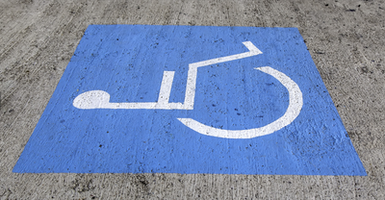
Get a Disabled Parking Permit in New York City: A Comprehensive Guide
In New York City, obtaining a disability tag (also known as a parking placard or permit) is crucial for individuals with qualifying medical conditions that make it difficult to navigate the city's busy streets and limited parking. This article will walk you through the steps of obtaining a disabled parking permit in New York City (NYS permit), the benefits of applying online with HandicapMD.com, and the differences between the NYS permit and the NYC PPPD permit. We will also cover key topics like eligibility, fees, expiration, renewals, and much more to ensure you have all the information you need.
Qualifying Medical Condition for a Disability Tag in New York City
To be eligible for a New York State (NYS) disability tag, an applicant must demonstrate that they have a qualifying medical condition that significantly impairs their ability to move or access transportation easily. The key criterion centers on mobility limitations, specifically the inability to walk a specified distance without assistance or requiring parking accommodations due to the severity of their disability.
Overview of Eligibility Requirements:
In New York, the primary focus of the disability tag program is to ensure that individuals with mobility challenges have access to convenient parking, often near entrances of buildings, to mitigate the challenges posed by their conditions. The disability must be certified by a licensed healthcare provider, such as a physician, physician assistant, nurse practitioner, or chiropractor, who will verify the applicant’s medical condition and its impact on their mobility. This certification is required when submitting the application for a disability tag.
Qualifying Medical Conditions for a New York State Disability Tag:
Cardiovascular Diseases: Individuals with heart conditions may qualify if their cardiovascular disease affects their ability to move efficiently. Conditions such as heart failure, arrhythmias, or ischemic heart disease can lead to symptoms like fatigue, chest pain, or dizziness, which impair the ability to walk long distances. These conditions often cause shortness of breath (dyspnea) or a reduced ability to exert oneself, making parking closer to destinations a necessary accommodation. Healthcare providers may certify applicants based on the severity of these symptoms and how they restrict mobility.
Respiratory Conditions: Applicants with chronic lung diseases like asthma, chronic obstructive pulmonary disease (COPD), emphysema, or pulmonary fibrosis may qualify for a disability tag. These respiratory disorders restrict airflow, leading to difficulties in breathing, especially during physical activity. Individuals with these conditions often experience shortness of breath with minimal exertion, which limits their capacity to walk even short distances. As a result, they may require parking accommodations that allow them to stay close to building entrances or avoid strenuous walks across large parking lots.
Orthopedic Impairments: Individuals with orthopedic impairments, such as arthritis, joint issues, or musculoskeletal disorders, often struggle with mobility due to pain, stiffness, and reduced range of motion. For instance, severe osteoarthritis or rheumatoid arthritis can cause debilitating pain in the knees, hips, or spine, which severely limits a person's ability to walk or stand for extended periods. Additionally, individuals recovering from surgeries such as joint replacements or fractures may also qualify temporarily while they heal and regain mobility.
Neurological Disorders: Conditions affecting the nervous system, like multiple sclerosis (MS), Parkinson’s disease, stroke-related disabilities, or cerebral palsy, may impede a person's ability to walk or balance. Individuals with these disorders often experience muscle weakness, tremors, lack of coordination, or spasticity, which can make walking long distances impossible without assistive devices or frequent rest. For instance, someone recovering from a stroke may struggle with partial paralysis or muscle weakness, leading to significant mobility impairments.
Visual Impairments: Severe vision loss or blindness can qualify an individual for a disability tag if their condition significantly impacts their ability to navigate their surroundings safely. Vision impairments can increase the risk of falls, accidents, or disorientation, which makes parking accommodations closer to entrances a necessity. In New York, while vision impairments alone may not always qualify someone for a tag, if the condition impacts mobility or requires assistive devices like a cane or guide dog, the individual can apply for a disability tag.
Use of Assistive Devices: Individuals who rely on assistive devices such as crutches, canes, walkers, prosthetics, or wheelchairs due to their condition automatically qualify for a disability tag, as the need for these devices indicates a significant mobility impairment. Applicants with conditions such as amputation, severe joint degeneration, or spinal cord injuries that necessitate the use of these aids will find it difficult to move long distances or navigate standard spaces without difficulty.
Other Potential Qualifying Conditions:
In addition to the common conditions listed above, other less frequent but equally impactful conditions can qualify individuals for a disability tag. For example:
- Severe chronic pain conditions, such as fibromyalgia or complex regional pain syndrome (CRPS), can severely limit an individual’s ability to move without pain, necessitating accommodations.
- Metabolic diseases like diabetes, when associated with complications such as peripheral neuropathy or lower limb amputations, can impede mobility and qualify for a tag.
- Cancer treatments, including chemotherapy or radiation, can lead to severe fatigue and reduced physical capabilities, sometimes temporarily qualifying individuals for a disability tag.
Application Process:
To apply for an NYS disability tag, the applicant must first consult with a healthcare provider to confirm that their condition qualifies under state regulations. The healthcare provider will fill out a certification form, detailing the individual’s medical condition and explaining how it impairs their mobility. This certification is critical, as it serves as proof of the need for a disability tag.
- Medical Certification: The healthcare provider must confirm the specific nature of the disability, specifying how it limits the individual’s ability to walk or necessitates accommodations.
- Filing the Application: The completed certification must be submitted along with an application to the local New York Department of Motor Vehicles (DMV) or municipality, depending on whether the tag is being requested for city or statewide use.
- Temporary vs. Permanent Tags: Applicants can apply for either a temporary or permanent disability tag, depending on the nature of their condition. Temporary tags are typically issued for short-term conditions like surgery recovery, while permanent tags are for chronic or long-term conditions.
- Renewals and Re-Certifications: Permanent tags must be renewed periodically, and individuals may need to be re-evaluated by their healthcare provider to ensure they still meet the eligibility requirements.
Why Accommodations Matter:
For individuals with these qualifying conditions, parking accommodations are not just a convenience but a necessity. The ability to park in a space that is closer to building entrances or provides extra room for wheelchair access significantly improves their quality of life. Without these accommodations, many individuals would be unable to access essential services, workplaces, or community resources due to the limitations imposed by their conditions.
In summary, New York State provides disability tags to individuals who have documented, qualifying medical conditions that impede their mobility. These conditions range from heart and lung diseases to musculoskeletal, neurological, and visual impairments. By offering accommodations, the state ensures that individuals with disabilities can access transportation and public spaces more easily, improving their daily living experience.
How to Obtain a Permit Online with HandicapMD.com
Getting a disability tag online can streamline the process for individuals who may find it difficult to visit physical locations like the DMV due to their medical conditions. HandicapMD.com offers an easy, efficient way to obtain medical certification for a disability tag from the comfort of your home.
Here’s how you can obtain a tag online through HandicapMD.com:
Step 1: Medical Evaluation
First, visit the HandicapMD.com website, where you can schedule a telehealth consultation with a certified healthcare provider. This consultation will allow the doctor to evaluate your medical condition and determine if you meet the criteria for a disability tag under New York State guidelines.Step 2: Documentation Review
You will be asked to upload relevant medical records and any existing documentation that supports your application. These records help the doctor verify your eligibility.Step 3: Approval and Submission
Once the doctor completes your evaluation and certifies that you are eligible, the necessary forms will be filled out and provided to you. HandicapMD.com makes sure all forms are compliant with DMV regulations, ensuring that your submission process is as smooth as possible.Step 4: DMV Submission
After receiving the certified forms, you can submit them to the New York State DMV for processing. HandicapMD.com provides clear instructions on how to submit the forms, including online submission options if available.
Applying online is a great way to save time, avoid physical trips to medical offices, and ensure that your documentation is handled by professionals who specialize in disability permits.
Distinguishing Between the NYS Permit and the NYC PPPD Permit
It is critical to distinguish between the New York State (NYS) disability tag and the New York City Parking Permits for People with Disabilities (NYC PPPD). Although they sound similar, these two tags serve different purposes, have different eligibility requirements, and offer distinct privileges.
NYS Disability tag:
The NYS permit is a statewide placard that allows individuals with qualifying disabilities to park in any location that has designated disability spots. This permit is especially useful for those who frequently travel outside of New York City or who live in boroughs where street parking might not offer specific accommodationsfor disability parking. The NYS permit is valid across the entire state and allows the user to park in designated accessible spaces in any city or town.
Key features of the NYS Disability Permit:
- Valid throughout New York State: Holders can park in any accessible parking spaces statewide, making it ideal for those who travel frequently.
- Issued by the DMV: Applicants must go through the New York State DMV process, often requiring a certified doctor to fill out specific forms.
- Accessible Spaces: The tag grants access to any designated space for disabled individuals, which are found in shopping centers, business districts, hospitals, and more.
NYC PPPD (Parking Permit for People with Disabilities):
The NYC PPPD tag is issued specifically by the New York City Department of Transportation and has more limited use than the NYS disability tag. It is designed for people with disabilities who live in or frequently travel through New York City’s five boroughs. However, the NYC PPPD allows for on-street parking in many areas where parking is otherwise restricted, such as meter spaces or "No Parking" zones, which are not accessible with the NYS permit.
Key features of the NYC PPPD tag:
- Limited to New York City: The NYC PPPD tag allows you to park in certain restricted areas within the five boroughs of New York City but does not allow access to statewide disability spots outside of NYC.
- On-Street Parking Privileges: The NYC PPPD offers more flexibility for on-street parking in New York City, including access to metered spots, some no-parking zones, and other restricted areas.
- Issued by NYC DOT: The NYC PPPD is not issued by the DMV but by the New York City Department of Transportation. The application process is also different, requiring specific forms and medical certification from a doctor.
While both the NYS permit and the NYC PPPD provide important accommodations for people with disabilities, the key difference lies in where and how they can be used. If you live in New York City and need greater flexibility for on-street parking, the NYC PPPD may be a better option. However, if you travel frequently or need statewide parking accommodations, the NYS tag is the way to go.
HandicapMD.com can assist you with obtaining the NYS tag, and the process can be done entirely online, making it more convenient for those with limited mobility or complex medical conditions.
Why Is Getting the Tag Online Beneficial?
There are several advantages to obtaining your NYS disability tag online through HandicapMD.com:
- Convenience: You can complete the entire process from the comfort of your home, without needing to visit a doctor's office or DMV location.
- Efficiency: HandicapMD.com provides a streamlined approach to documentation and certification, ensuring your forms are filled out correctly and promptly.
- Expertise: HandicapMD.com specializes in handling disability tag applications, ensuring compliance with all DMV regulations and improving your chances of approval.
- Time-Saving: Avoiding the DMV or doctor’s office eliminates long waiting times and helps you receive your tag faster.
- Accessibility: For those with limited mobility, applying online removes the barrier of transportation and physical attendance, making the process smoother and more manageable.
Fee
For the NYS disability tag, there is no fee charged for the tag itself. However, if you choose to obtain your medical certification through HandicapMD.com, there may be a consultation fee for the telehealth appointment. Fees for telehealth evaluations vary, but HandicapMD.com is competitively priced to ensure that you can access the certification without financial burden.
Validity/Expiration of Permits
Once you obtain your NYS disability tag, it is generally valid for up to five years. The exact expiration date will be printed on the placard, and you must renew it before it expires to avoid losing privileges. It is essential to keep track of the expiration date to ensure that your tag remains valid and that you continue to benefit from accessible parking.
Renewals
Renewing your disability tag in New York City is a straightforward process. HandicapMD.com can assist with renewals by offering another telehealth evaluation to recertify your medical condition. If your condition remains unchanged or worsens, renewal will typically be granted without any issues.
Once you receive your renewal certification, you can submit it to the DMV for processing. Be sure to renew before the expiration date to avoid a lapse in your privileges.
Lost, Stolen, or Damaged Placards
If your disability tag is lost, stolen, or damaged, you must report it to the DMV as soon as possible. You will need to fill out a form to request a replacement placard. HandicapMD.com can help by providing the medical certification again if required.
For a lost or stolen placard, you may also be required to provide a police report as part of the replacement process.
Where to Hang the Placard
The NYS disability tag is a placard that must be hung from your rearview mirror when you park in a designated accessible spot. It should only be displayed when your vehicle is parked; it is illegal to drive with the placard hanging from your rearview mirror as it can obstruct your view.
Ensure that thehandicap placard in New York is visible from outside the vehicle so that parking enforcement officers can verify that you are authorized to park in accessible spaces.
Obtaining a disability tag in New York City can significantly improve your ability to navigate the city and access accommodations. Whether you need a tag for yourself or a family member, HandicapMD.com offers an efficient, accessible way to get your medical certification online. Don't wait to enjoy the convenience of accessible parking—visit HandicapMD.com today to start your application for a New York State disability tag.
Remember, HandicapMD.com is here to make the process easier and more convenient for you.
.png)





